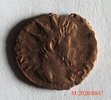
"Laetitia, deriving from the root word laeta, meaning "happy", "glad", "lucky", "successful", "prosperous", "luxurious", "lush", or "abounding", was a minor Roman goddess of gaiety. Her name was used to mean happiness with prosperity and abundance. She is usually shown with greenery to depict the abundance of seasonal decorations that many sites would include. Wreaths of flowers or leaves are commonly worn at festivals or holy rituals, similarly Laetitia would be shown wearing a garland to mean celebration. She was sometimes depicted on Roman coinage with an anchor, as a representation of stability, or, like Fortuna, a ship's rudder symbolizing guiding fortune or the actions chosen to steer one towards prosperity, fortune favors the strong which was used to be used synonymously with social class, it was also used to describe fertile land." - (Wikipedia (en) 30.12.2020)
 )
)






